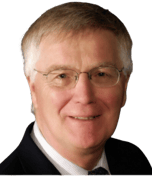Get to Know Sandy McEwan, MB, FRCPC, FSNMMI
Bracken
With over forty years of experience in nuclear medicine, oncology, and molecular imaging, Dr. Sandy McEwan is a world-renowned expert in his field.
Sandy has a long list of titles under his belt: Chief Medical Officer at Ariceum, a company developing novel medicines for systemic targeted radiotherapy (SRT); Vice President of Radiopharmaceuticals at Ipsen; and for almost 20 years Chairs of both the Departments of Radiology, and of Oncology, at the University of Alberta. He worked as a physician at Alberta Health Services for over thirty years, including roles as Clinical Director of the Cross Cancer Institute, and Clinical Head of Diagnostic Imaging at the University of Alberta Hospital. To top it all off, Sandy has an impressive background in clinical research, and has over 120 publications. He has also been a member of the Canadian Nuclear Safety Commission and was President of the Society of Nuclear Medicine and Molecular Imaging in 2007/2008.
Sandy joined Bracken as a consultant in October of 2022, and his experience—and profound expertise—have been a crucial addition to the team. We recently sat down with Sandy to learn about the last four decades of his impressive career, his passion for a wide-ranging field of medicine, and the differences between working in industry vs. the academic sector.
 Q: To start us off, can you tell us a bit about your background and what drew you to work in the radiopharmaceutical, molecular imaging, and oncology fields?
Q: To start us off, can you tell us a bit about your background and what drew you to work in the radiopharmaceutical, molecular imaging, and oncology fields?
A: I went to medical school in London. At the end of my degree, I had little idea what I wanted to do. I thought, maybe, I wanted to do oncology. But I wasn't sure. So, I joined the Navy, where I was member of a team that taught people how to escape from submarines. I became interested in diving medicine and pressure related injuries in deep sea divers.
Q: What do those latter interests entail? Or what were your career highlights when you were in the Navy?
A: : I got really interested in a condition called dysbarism, which is pressure related injury, found in deep sea divers and experimental divers. These are injuries that are related to long term exposure to increased atmospheric pressure, as is seen in these divers. Pressure changes can also have adverse effects on the human body when involved in rapid changes of pressure, for example in submarine escapes. These can especially occur in the brain, where stroke like symptoms can be seen. Obviously, these injuries can also happen in the lungs, and in bone; the field has obviously moved on considerably since then. This period is when I was introduced to nuclear medicine, which we then used to investigate patients with these conditions. Remember, this was pre-CT and pre-MRI. At the time it was the only medical tool available for imaging biochemistry or imaging physiology in the living human; it still remains an important tool along with advances in MRI/MRS protocols. In my last few years in the Navy, I completed my basic nuclear medicine training. And then I completed my master’s degree.
Q: Where did your work take you next?
A: I went to New Zealand and did two years training in oncology. After two years, I was offered a chance at a fellowship position in radiopharmaceuticals and radiopharmaceutical therapy back in the UK. It was there that I was able to tie together my oncology training and interests in imaging, radiopharmaceuticals, biology, biochemistry, and physiology. It was a fantastic introduction to clinical patient care in what was effectively a new discipline.
Q: That marriage of topics sounds like a fantastic intersection of your interests. Could you share some key highlights of your career?
A: Once in Edmonton, my colleagues and I started expanding the nuclear medicine service, including the introduction of an active clinical and translational research therapy program. Then I got invited to be head of the radiology department at the University Hospital, and Chair of Radiology and Diagnostic Imaging at the end of 1991. I stayed there until 1999, when I went back to the cancer clinic to establish a PET program, and to collaborate on further expanding the radioisotope therapy program. In 2007, I was asked to become Chair of Oncology, which I was for 10 years until 2017. During that time, we did some fantastic recruitments that garnered some of the best oncology researchers in North America. We also developed collaborations with the research MR unit in the University. The radiopharmaceutical therapy program expanded to become the largest in North America at the time.
Other than that, there are additional accomplishments I’m proud of. In the Navy, I got a commander in chief’s commendation for saving a man with a pressure related injury following a practice submarine escape. I’m probably the only person you know who has done CPR 70 meters down.
I was involved with the first radiopharmaceutical clinical trial that was randomized and blinded. I was also the leader of the development of the Edmonton PET program, which was one of the first academic clinical oncology programs in the country. Establishing a radiation therapist degree program was also a major source of pride. We were able to get funding to ensure it was unique in terms of didactic offerings, in terms of supporting educational equipment, and ensured that it was scientifically and clinically rigorous. It produced (and continues to produce) superbly trained radiation therapists.
Q: You’ve had quite an impressive career—and your list of over 120 academic publications, most in radiopharmaceuticals, is proof of that alongside your accomplishments. What are differences that you’ve found in working in the academic sphere versus working in the industry?
A: Working in industry is much slower. That surprised me. It's more bureaucratic; the pace is narrower. Obviously, the reward system is different. And the goals are very different.
Q: What drew you to consulting? How long have you been in that space?
A: I’ve been an active consultant for six months. I stepped down as Chair in 2017. I also found the healthcare system in Alberta was increasingly becoming patient unfriendly. I decided to retire, but life had other plans. I got a phone call from Ipsen about working with two novel therapeutic radiopharmaceuticals. This role lasted for two years, when the drug was sold to Ariceum Therapeutics, a start up with a quite extraordinarily talented team of scientists and entrepreneurs leading it. I was the founding CMO. I finished that [project] in October [2022], and then was on gardening leave until July of this year when I was able to become active with Bracken, although Colin had invited me to join the previous July.
Q: As a Bracken consultant, how do you see yourself helping small to medium biopharma or radiopharmaceutical companies?
A: I have background knowledge in many fields. Radiopharmaceuticals, clinical trials, pharmaceutical development and therapies, and radiobiology. I think I understand the biology of isotope therapies. Although I’ve spent my career in academia, I have frequently worked with industry as a consultant or researcher on various clinical trials and novel compounds. I believe I know what works and what doesn’t. To drill it down: I bring common sense, background, and perspective.
Q: What excites you about working at Bracken?
A: I think what Bracken has built is quite innovative. The team environment is wonderful. And there’s so much to be achieved.
Contact us today to learn more about working with Sandy and Bracken’s team of expert consultants.


.png?width=352&name=Blog%20Headers%20(56).png)
.png?width=352&name=Blog%20Headers%20(18).png)